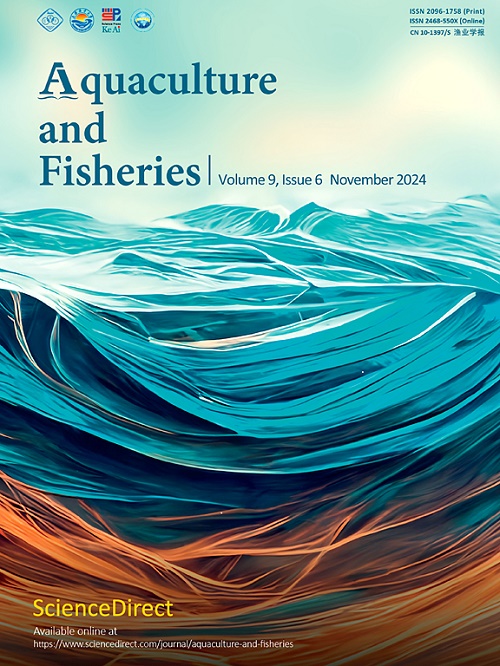咸水循环水产养殖系统中欧洲鲈鱼和尼罗罗非鱼的多重养殖:对生长性能、饲料利用率和健康状况的影响
Q1 Agricultural and Biological Sciences
引用次数: 0
摘要
非传统水产养殖方法对于克服气候变化后果至关重要,特别是在遭受水资源短缺的国家。混养策略依赖于不同水生动物物种之间的多样化和组合,以加快养殖物种的生长,提高可利用资源的利用率。在一个循环水养殖系统(RAS)中,将欧洲鲈鱼和尼罗罗非鱼在咸淡水(盐度12)中进行复合养殖。为此,将鱼分成5组,每组3条。第一组(G1)水族缸(120 L)是满40标本的欧洲鲈鱼,第二组(G2)满30标本的欧洲鲈鱼+ 10尼罗罗非鱼的标本,第三组(G3)满20标本的欧洲鲈鱼+ 20标本的尼罗罗非鱼,第四组(G4)满10标本的欧洲鲈鱼+ 30标本的尼罗罗非鱼,和第五集团(G5)满40尼罗罗非鱼的标本。G2、G3、G4和G5的溶解氧(DO)、总氨氮(TAN)和NH3-N水平均高于G1 (P <;0.05)。除G5外,欧洲鲈鱼G4的生长性能指标(FW、WG和SGR)均高于G1、G2和G3 (P <;0.05)。另一方面,G2组尼罗罗非鱼的FW、WG和SGR高于G3、G4和G5组(P <;0.05)。G3多养欧洲鲈鱼和尼罗罗非鱼的总生物量高于G1和G5 (P <;0.05)。各组间体细胞指标差异无统计学意义(P > 0.05)。与初始胴体组成相比,欧洲鲈鱼的粗蛋白质和总脂肪含量显著增加(P <;0.05)。此外,与初始胴体组成相比,尼罗罗非鱼的总脂含量显著增加(P <;0.05)。此外,各组间血液总蛋白、白蛋白、球蛋白、ALT和AST均无显著差异(P < 0.05)。综上所述,在不影响生长性能、健康状况和生存能力的情况下,在RAS中添加微淡水养殖欧洲鲈鱼和尼罗罗非鱼是适宜的。本文章由计算机程序翻译,如有差异,请以英文原文为准。
Polyculture of European seabass and Nile tilapia in the recirculating aquaculture system with brackish water: Effects on the growth performance, feed utilization, and health status
Non-traditional aquaculture practices are crucially needed to overcome the climate change consequences, especially in countries suffering from water shortages. Polyculture strategy depends on the diversification and compilation between different aquatic animal species to fasten farmed species' growth and improve available resources' utilization. In this study, European seabass and Nile tilapia were poly-cultured in brackish water (salinity 12) in a recirculating aquaculture system (RAS). For this reason, fish were distributed into five groups with triplicates in each. The first group (G1) of aquaria (120 L) was stocked with 40 specimens of European seabass, the second group (G2) was stocked with 30 specimens of European seabass + 10 specimens of Nile tilapia, the third group (G3) was stocked with 20 specimens of European seabass + 20 specimens of Nile tilapia, the fourth group (G4) stocked with 10 specimens of European seabass + 30 specimens of Nile tilapia, and the fifth group (G5) stocked with 40 specimens of Nile tilapia. The dissolved oxygen (DO), total ammonia nitrogen (TAN), and NH3–N showed higher levels in G2, G3, G4, and G5 than in G1 (P < 0.05). Except for G5, European seabass showed higher growth performance indices (FW, WG, and SGR) and lower FCR in G4 than in G1, G2, and G3 (P < 0.05). On the other hand, Nile tilapia growing in G2 resulted in higher FW, WG, and SGR and lower FCR than in G3, G4, and G5 (P < 0.05). The total biomass of poly-cultured European seabass and Nile tilapia is higher in G3 than in G1 and G5 (P < 0.05). All groups had no significant differences in the somatic indices (P˃0.05). In European seabass, the crude protein and total lipids were significantly increased in fish compared to the initial carcass composition (P < 0.05). Besides, in Nile tilapia, the total lipids were significantly increased in fish compared to the initial carcass composition (P < 0.05). Furthermore, no significant differences were seen between all groups (P>0.05) on the blood total protein, albumin, globulin, ALT, and AST. In conclusion, the polyculture strategy is appropriate for farming European seabass and Nile tilapia in RAS with brackish water without compromising growth performance, health status, and survivability.
求助全文
通过发布文献求助,成功后即可免费获取论文全文。
去求助
来源期刊

Aquaculture and Fisheries
Agricultural and Biological Sciences-Aquatic Science
CiteScore
7.50
自引率
0.00%
发文量
54
审稿时长
48 days
期刊介绍:
 求助内容:
求助内容: 应助结果提醒方式:
应助结果提醒方式:


